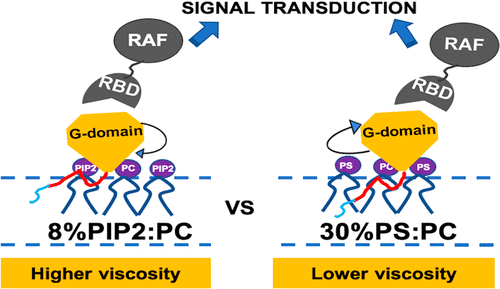当前位置:
X-MOL 学术
›
J. Phys. Chem. B
›
论文详情
Our official English website, www.x-mol.net, welcomes your
feedback! (Note: you will need to create a separate account there.)
How Anionic Lipids Affect Spatiotemporal Properties of KRAS4B on Model Membranes.
The Journal of Physical Chemistry B ( IF 2.8 ) Pub Date : 2020-05-21 , DOI: 10.1021/acs.jpcb.0c02642 Van A Ngo 1 , Sumantra Sarkar 1 , Chris Neale 2 , Angel E Garcia 1
The Journal of Physical Chemistry B ( IF 2.8 ) Pub Date : 2020-05-21 , DOI: 10.1021/acs.jpcb.0c02642 Van A Ngo 1 , Sumantra Sarkar 1 , Chris Neale 2 , Angel E Garcia 1
Affiliation

|
RAS proteins are small membrane-anchored GTPases that regulate key cellular signaling networks. It has been recently shown that different anionic lipid types can affect the spatiotemporal properties of RAS through dimerization/clustering and signaling fidelity. To understand the effects of anionic lipids on key spatiotemporal properties of RAS, we dissected 1 ms of data from all-atom molecular dynamics simulations for KRAS4B on two model anionic lipid membranes that have 30% of POPS mixed with neutral POPC and 8% of PIP2 mixed with POPC. We unveiled the orientation space of KRAS4B, whose kinetics were slower and more distinguishable on the membrane containing PIP2 than the membrane containing POPS. Particularly, the PIP2-mixed membrane can differentiate a third kinetic orientation state from the other two known orientation states. We observed that each orientation state may yield different binding modes with an RAF kinase, which is required for activating the MAPK/ERK signaling pathway. However, an overall occluded probability, for which RAF kinases cannot bind KRAS4B, remains unchanged on the two different membranes. We identified rare fast diffusion modes of KRAS4B that appear coupled with orientations exposed to cytosolic RAF. Particularly, on the membrane having PIP2, we found nonlinear correlations between the orientation states and the conformations of the cationic farnesylated hypervariable region, which acts as an anchor in the membrane. Using diffusion coefficients estimated from the all-atom simulations, we quantified the effect of PIP2 and POPS on the KRAS4B dimerization via Green’s function reaction dynamics simulations, in which the averaged dimerization rate is 12.5% slower on PIP2-mixed membranes.
中文翻译:

阴离子脂质如何影响模型膜上KRAS4B的时空特性。
RAS蛋白是小膜锚定的GTPases,可调节关键的细胞信号网络。最近已经表明,不同的阴离子脂质类型可以通过二聚化/聚类和信号保真度影响RAS的时空特性。为了了解阴离子脂质对RAS关键时空特性的影响,我们在两个模型阴离子脂质膜上对KRAS4B的全原子分子动力学模拟解剖了1 ms的数据,该模型具有30%的POPS与中性POPC和8%的PIP2与POPC混合。我们揭示了KRAS4B的取向空间,它的动力学比含POPS的膜在含PIP2的膜上动力学更慢且更可分辨。特别地,PIP2混合膜可将第三动力学取向状态与其他两个已知的取向状态区分开。我们观察到每个方向状态可能会产生与RAF激酶不同的结合模式,这是激活MAPK / ERK信号通路所必需的。但是,RAF激酶不能结合KRAS4B的总体封闭概率在两种不同的膜上均保持不变。我们确定了罕见的KRAS4B快速扩散模式,出现与暴露于胞质RAF的方向相结合。特别地,在具有PIP2的膜上,我们发现了取向状态与阳离子法呢基化的高变区的构象之间的非线性相关性,所述阳离子法呢基化的高变区充当膜中的锚。使用通过全原子模拟估算的扩散系数,我们通过格林的功能反应动力学模拟量化了PIP2和POPS对KRAS4B二聚化的影响,
更新日期:2020-07-02
中文翻译:

阴离子脂质如何影响模型膜上KRAS4B的时空特性。
RAS蛋白是小膜锚定的GTPases,可调节关键的细胞信号网络。最近已经表明,不同的阴离子脂质类型可以通过二聚化/聚类和信号保真度影响RAS的时空特性。为了了解阴离子脂质对RAS关键时空特性的影响,我们在两个模型阴离子脂质膜上对KRAS4B的全原子分子动力学模拟解剖了1 ms的数据,该模型具有30%的POPS与中性POPC和8%的PIP2与POPC混合。我们揭示了KRAS4B的取向空间,它的动力学比含POPS的膜在含PIP2的膜上动力学更慢且更可分辨。特别地,PIP2混合膜可将第三动力学取向状态与其他两个已知的取向状态区分开。我们观察到每个方向状态可能会产生与RAF激酶不同的结合模式,这是激活MAPK / ERK信号通路所必需的。但是,RAF激酶不能结合KRAS4B的总体封闭概率在两种不同的膜上均保持不变。我们确定了罕见的KRAS4B快速扩散模式,出现与暴露于胞质RAF的方向相结合。特别地,在具有PIP2的膜上,我们发现了取向状态与阳离子法呢基化的高变区的构象之间的非线性相关性,所述阳离子法呢基化的高变区充当膜中的锚。使用通过全原子模拟估算的扩散系数,我们通过格林的功能反应动力学模拟量化了PIP2和POPS对KRAS4B二聚化的影响,











































 京公网安备 11010802027423号
京公网安备 11010802027423号